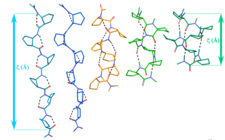Conformational studies of β-amino acids, oligo- and polypeptides
Backbone modified β-amino acids are prime candidates to increase the half-life of peptides / drugs / hormones under physiological conditions. Their incorporation into polypeptides and proteins is possible without disrupting secondary structural element of proteins. These α/β-chimeras successfully resist against proteolysis quite effectively compared to the parent macromolecules. However, introducing additional main chain atom(s) clearly add to the complexity, conformational landscape and flexibility of these molecules. We have recently shown that replacing α-amino acids with conformationally constrained cyclic β-residues instead of their open-chain variants is, in some cases at least, preferred for sustaining the bioactive conformation and the in vivo activity of the parent compound. Systematic conformational search was therefore carried out for monomers and homohexamers of furanoid β-aminoacids. The hexamers of cis- and trans furanoid β-amino acids and β-sugar amino acids show great variability, though their secondary structure preference can often be foreseen form their building blocks.

Kapcsolódó publikációk
-
Tamás Beke , Imre G. Csizmadia , András Perczel
Theoretical study on tertiary structural elements of β-peptides: Nanotubes formed from parallel-sheet-derived assemblies of β-peptides
J. Am. Chem. Soc. 128:5158-5167. (2006) Kivonat -
Tamás Beke , András Czajlik , Imre G. Csizmadia , András Perczel
Determining suitable lego-structures to estimate stability of larger nanostructures using computational methods
Phys. Biol. 3:S26-S39. (2006) Kivonat -
Tamás Beke , Csaba Somlai , András Perczel
Toward a rational design of β-peptide structures.
J. Comput. Chem. 27:20-38. (2006) Kivonat -
András Láng , Anna K. Füzéry , Tamás Beke , Péter Hudáky , András Perczel
Potential energy curves, surfaces and hypersurfaces. A model to follow and understand the conformational transformations in amino acids.
J. Mol. Struct. (THEOCHEM) 675(1-3):163-175. | http://dx.doi.org/10.1016/j.theochem.2003.12.047 (2004) Kivonat -
Dóra K. Menyhárd , Ilona Hudáky , Imre Jákli , György Juhász , András Perczel
Predictable conformational diversity in foldamers of sugar amino acids
J. Chem. Inf. Model. 57(4):757–768. DOI: 10.1021/acs.jcim.6b00488 (2017) Kivonat